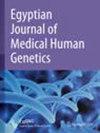Genetic-driven biomarkers for liver fibrosis through bioinformatic approach
IF 1.2
Q4 GENETICS & HEREDITY
引用次数: 0
Abstract
Liver fibrosis is a widespread chronic liver ailment linked to substantial mortality and limited therapeutic options. An in-depth comprehension of the genetic underpinnings of liver fibrogenesis is crucial for the development of effective management and treatment approaches. Using bioinformatics tools and the DisGeNET database, we pinpointed 105 genes significantly linked to liver fibrosis. Subsequently, we conducted functional assessments, incorporating gene ontology (GO), Kyoto Encyclopedia of Genes and Genomes (KEGG) pathway enrichment analysis, and the STRING database, to construct protein–protein interaction networks (PPI) for these 105 liver fibrosis-associated genes. These analyses were executed via the WebGestalt 2019 online platform. We employed Cytoscape plugins, MCODE, and CytoHubba, to identify potential biomarker genes from these functional networks. Noteworthy hub genes encompassed TGF-β1, MMP2, CTNNB1, FGF2, IL6, LOX, CTGF, SMAD3, ALB, and VEGFA. TGF-β1 and MMP-2 exhibited substantial promise as liver fibrosis biomarkers, as denoted by their high systemic scores determined through the MCC algorithm in the CytoHubba methodology. In summary, this study presents a robust genetic biomarker strategy that may prove invaluable in the identification of potential liver fibrosis biomarkers.通过生物信息学方法研究肝纤维化的基因驱动生物标志物
肝纤维化是一种广泛存在的慢性肝病,死亡率高且治疗手段有限。深入了解肝纤维化的基因基础对于开发有效的管理和治疗方法至关重要。利用生物信息学工具和 DisGeNET 数据库,我们确定了 105 个与肝纤维化密切相关的基因。随后,我们结合基因本体论(GO)、京都基因与基因组百科全书(KEGG)通路富集分析和 STRING 数据库进行了功能评估,为这 105 个肝纤维化相关基因构建了蛋白质-蛋白质相互作用网络(PPI)。这些分析是通过 WebGestalt 2019 在线平台进行的。我们使用Cytoscape插件、MCODE和CytoHubba从这些功能网络中识别潜在的生物标记基因。值得注意的中心基因包括 TGF-β1、MMP2、CTNNB1、FGF2、IL6、LOX、CTGF、SMAD3、ALB 和 VEGFA。TGF-β1和MMP-2通过CytoHubba方法中的MCC算法确定了较高的系统评分,这表明它们有望成为肝纤维化生物标志物。总之,本研究提出了一种稳健的基因生物标志物策略,可能会被证明在鉴定潜在的肝纤维化生物标志物方面非常有价值。
本文章由计算机程序翻译,如有差异,请以英文原文为准。
求助全文
约1分钟内获得全文
求助全文
来源期刊

Egyptian Journal of Medical Human Genetics
Medicine-Genetics (clinical)
CiteScore
2.20
自引率
7.70%
发文量
150
审稿时长
18 weeks
 求助内容:
求助内容: 应助结果提醒方式:
应助结果提醒方式:


